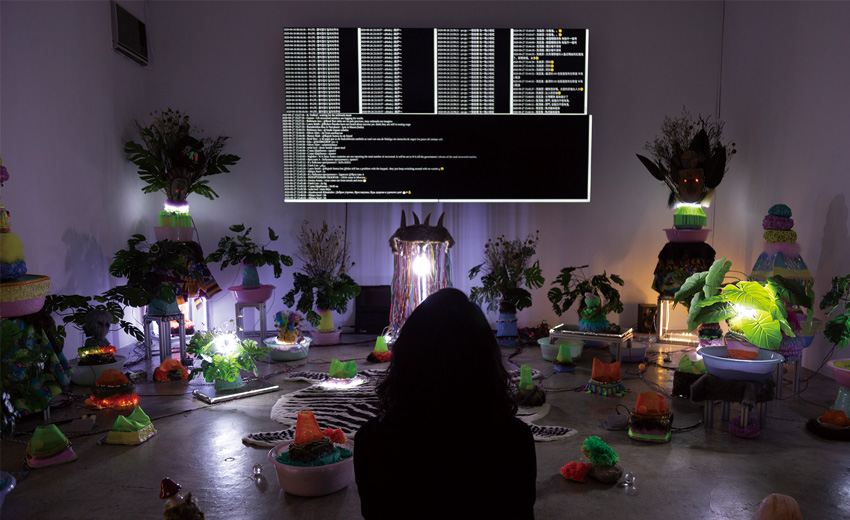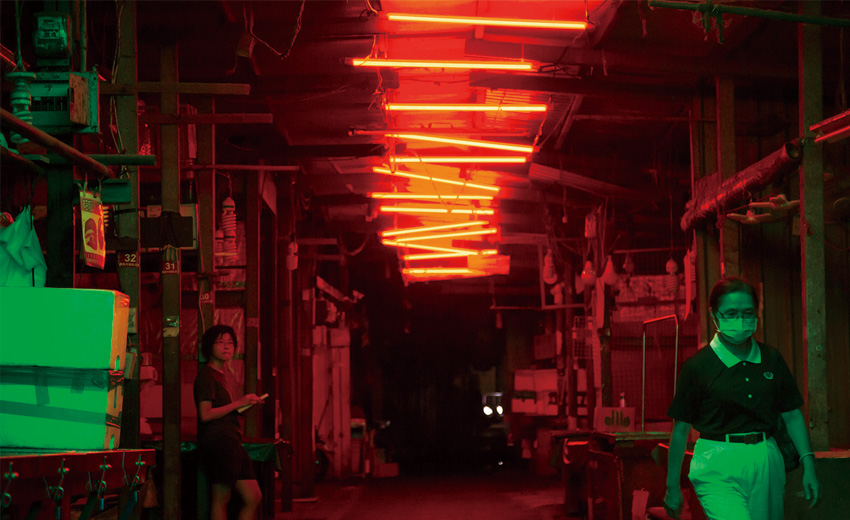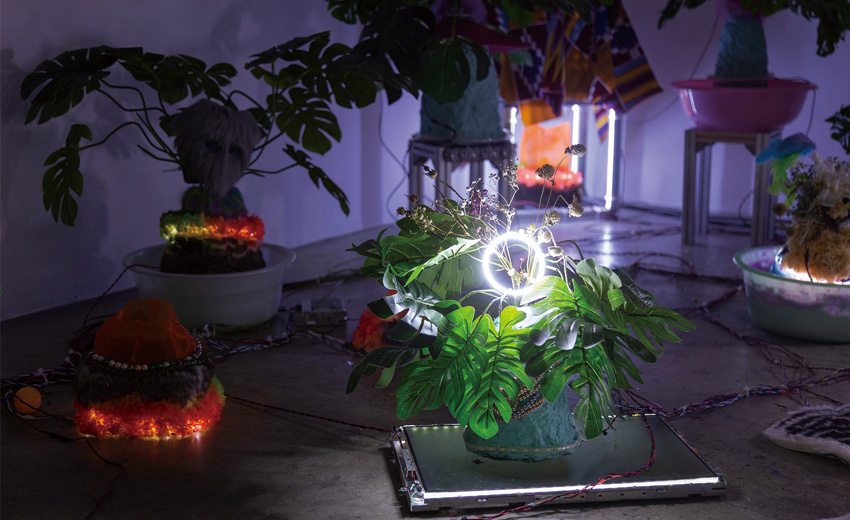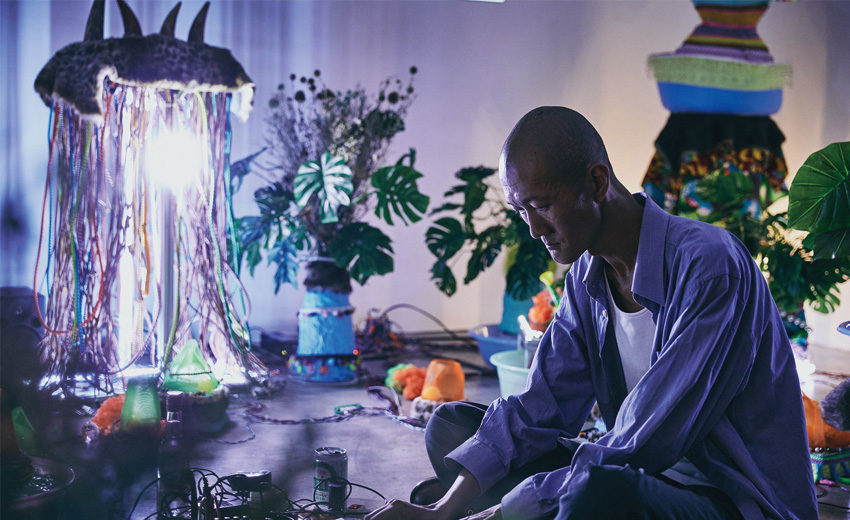本計劃以即時擷取網路酸文與假資訊等「垃圾訊息」為起始點,將其回收轉碼,成為操作機械、燈光與噪音音樂的資訊串,並連結立方計劃空間與龍泉市場兩個展出場域。新冠肺炎改變了當代生活的模式,疫情的衝擊不僅是政治經濟、與社會心理上的,也是集體感官經驗的改變。在市場空間內,藝術家將其轉化為一大型現地裝置,透過嗅覺、聽覺與視覺改變觀者的空間感知,以此探討氣味作為記憶載體、改變空間感知的重要角色。
This project uses “junk messages” such as online trolls and fake news as a starting point, recycling and converting the data into data streams to operate machines, lighting and noise music. It is shown at TheCube Project Space and Longquan Market at the same time. The COVID-19 pandemic has altered the patterns of contemporary life, inflicting as much an impact on politics and economy as on society and human psyche. Also, it has changed our collective sensory experience. The artists transform the market space into a large-scale site-specific installation, employing senses of smell, hearing and sight to alter the audience’s perception of the space. By doing so, the work explores using smell as a mnemonic carrier as well as its crucial role in altering spatial perception.
張碩尹,1982年生於台北,政大廣告系學士,倫敦大學金匠學院(Goldsmiths, University of London)藝術碩士。其創作媒材跨及裝置、繪畫、表演與錄像,並結合科學、生物學、生物動力學等不同知識領域,反應人與科技、社會的關係。近期獲獎包括英國皇家雕塑學會獎、香港Art Central新晉菁英大獎。作品受台北市立美術館、巴西駐英大使館、韓國Noblesse Collection、墨西哥JM SR Collection典藏,與亞洲歐洲私人收藏。
鄭先喻,1984年生於高雄,藝術家、軟體與機械開發人員。創作以電子裝置、軟體、生物能源實驗裝置為主,內容多在探討人類行為、情感、軟體與機械之間的關係,試圖以詼諧的方式去賦予作品某種生命象徵或是存在意義,藉此隱喻自身對於周遭環境的體會。其目前專注於生物學、電子、軟體等相關研究以及聲響、創作工具軟硬體的開發與創作,曾獲荷蘭YoungTalent入選、台北數位藝術獎首獎、高雄獎新媒體類優選、銅鐘藝術獎。
廖銘和(DINO),1976年生於台北,台灣九〇年代噪音第二波代表人物,曾為夾子樂隊成員。其創作標識九〇年代後半期台北噪音運動在技術上走向純類比電子,在內涵上建立獨立美學之里程碑。DINO的電子音響來自極其簡陋的模擬器材,利用線路雜音、靜電或麥克風回饋建立迴圈回路,在無音源的狀況下創造「買空賣空」的「再生音樂」(Recycle Music)。近年參與實驗電影、小劇場現場配樂製作,曾獲台北電影節最佳音效獎。
CHANG Ting-Tong was born in Taipei in 1982. He holds a BA in Advertising from National Cheng-Chi University and an MFA from Goldsmiths, University of London. His creative practice spans a variety of mediums, including installation, painting, performance and video, with which he combines different disciplines, such as science, biology and biokinetics, to reflect the relationship among humanity, technology and society. His major awards in recent years include the RBS Bursary Award (UK) and RISE Award (Hong Kong). His works can be found in the collections of Taipei Fine Arts Museum, the Embassy of Brazil London, the Noblesse Collection Seoul, the JM SR Collection Mexico and various private collections in Europe and Asia.
CHENG Hsien-Yu was born in Kaohsiung in 1984. An artist as well as a software and machine developer, his work revolves around electronic devices, software and experimental devices of bioenergy that explore the relationships among human behaviors, emotions, software and machines. With humorous approaches, he enriches his work with symbols of life and meanings of existence, which serves as metaphors for his understandings of the surrounding environment. He currently focuses on research about biology, electronics and software, as well as the development and creation of sounds, creative software and hardware. He was honored with the recognition of Young Talent in the Netherlands, and is the recipient of the First Prize of Taipei Digital Art Award, Honorable Mention in New Media Art of Kaohsiung Award, and Tung Chung Art Award.
DINO (LIAO Ming-Ho) was born in Taipei in 1976. He is an iconic figure in Taiwan’s second-wave noise in the 90s, and was a member of the music band, The Clippers. His work signals a technical transition of the noise movement in Taipei towards pure analog electronic sounds in the second half of the 90s, and establishes a milestone with its unique aesthetics. DINO’s electronic sounds are generated with extremely simple analog equipment. He utilizes circuitry noises, static or microphone feedback to create loops and generate “Recycle Music” without sonic input. In recent years, he has engaged in experimental film and live music production for experimental theater. He is a recipient of Best Sound Effects in the Taipei Film Festival.
張碩尹、鄭先喻、廖銘和
立方計劃空間、龍泉市場
關鍵字
藝術家談作品
每日攀升的得病與死亡數字、流竄的資訊,我們究竟如何面對與相信?在這樣劇烈的生活衝擊下,我們究竟失去了什麼?而這些失去又將產生什麼影響?《台北機電人2.0:訊息瘟疫》以兩個迥然不同的場域回應這些疑問。
採訪及文字整理|馮馨
2020年隨著新冠肺炎COVID-19爆發,非常狀態席捲全球,各國紛紛拉起封鎖線,鎖國封城,移動的自由不再,口罩、消毒、量測體溫成為必經的日常,每日攀升的得病與死亡數字、流竄的資訊,我們究竟如何面對與相信?在這樣劇烈的生活衝擊下,我們究竟失去了什麼?而這些失去又將產生什麼影響?《台北機電人2.0:訊息瘟疫》以兩個迥然不同的場域回應這些疑問。
向素人學習
《台北機電人2.0》的前身《台北機電人》為張碩尹2020年初於寶藏巖國際藝術村發表的創作計畫,當時張碩尹以臺北市的電器維修師傅與家庭工坊為目標,在各電子商場、環保回收站進行考察,並與維修師傅建立合作關係,學習維修與修改電器的技術,同時向民眾徵集家中損壞的電器與數位產品,以「廢棄品」創作一系列的機械裝置,並與長年進行噪音演出的Dino(廖銘和)合作,讓Dino使用這系列裝置做為發聲體,以其擅長利用線路雜音、靜電或麥克風回授(Feedback)建立迴圈迴路的造音方式演出。
張碩尹提及當時會想要以電器維修師傅做為考察與合作對象,主要是著迷於一種「素人狀態」,這些可能才國中畢業,甚至不識字的師傅們,在歷經師徒制的學習後,卻能維修高精密的電機電路板,這種從零摸索的狀態令張碩尹深有同感,至今回想自身的藝術創作之路,從最初還是Bbrother稱號的塗鴉客時期,到後來去倫敦大學金匠藝術學院(Goldsmiths, University of London)求學摸索裝置作品創作方法的狀態,張碩尹也覺得是一種相當素人的狀態。
回收廢料與垃圾訊息再製為新
延續1.0「回收–生產裝置/訊號迴路–產生聲音」的模式,並回應《台北機電人2.0》創作發展期間的疫情狀態。《台北機電人2.0》分別於立方計劃空間與龍泉市場展出,並加入了鄭先喻一同合作。在立方計劃空間可以看到一個四頻道銀幕於展場中央,螢幕上呈現鄭先喻設計的程式即時擷取臺灣、日本、韓國等地對疫情的討論,其中包含各式假消息、網路酸文與論戰.這些「垃圾訊息」被程式萃取,轉化成機械裝置中點亮LED燈與馬達扭動的驅動碼,也在Dino演出時成為即時影響Dino噪音表演的材料;而這些訊號也同時影響龍泉市場內的裝置啟動噴出氣味。
從電子廢料的取用並將其製作為裝置,什麼是廢料?廢料是否無用?而無用的資訊與假消息是否為一種「垃圾訊息」?「垃圾訊息」該如何被定義?這些從物質到資訊間的生產、轉化、再製、循環的流動關係,成為這個系列不斷滾動發展的生產邏輯與驅動力。
重返市場──透過氣味改造場域的想像
龍泉市場是張碩尹赴歐深造前最後舉辦展覽之處,選擇龍泉市場一方面出自私人情感,一方面也取自疫情爆發的最初,有一說法病毒的源頭即是來自海鮮市場,張碩尹以「溼市場」與網路同樣作為一種溫床的隱喻,醞釀、擴散病毒與訊息。張碩尹回想2020年疫情開始於歐洲爆發,那三個月因為一連串防疫措施:長時間戴口罩、噴酒精、消毒所造成的嗅覺剝奪,使得一切彷彿保持著一種距離,缺少體感的距離,也同時缺少了一種場景的記憶。
張碩尹將這樣的自身經歷轉化至龍泉市場的展出,把市場中濃烈的特有氣味與潮溼狀態,編輯至現場觀眾經由QR code掃描聆聽的文本,與LFP香料香水實驗室合作的「氣味裝置」,透過設計的氣味帶出兩種氛圍情境,一個情境設定漫步森林中聞到的芬多精,一個則是在浴室中清潔、洗澡的沐浴精。當觀眾走入由RGB紅、綠、藍色光段的市場走道,不時噴發的裝置氣味與市場的原先氣味雜揉,這些氣味又分別呼應了聲音文本中的敘事場景。張碩尹試圖以數位呈像的三原色光、氣味裝置、聲音文本,在嗅覺因疫情而有所限制與受損的今日,以嗅覺帶動的情境感受,重新擾動觀眾對於一個習以為常的場域想像。
評審談作品
創作者對當代議題高度敏感,以藝術創作的能動性,揭露了爆炸性訊息的煽動力,以及在不知盡頭的疫情蔓延時刻下,人的赤裸處境。
第19屆 台新藝術獎 視覺藝術獎 得獎理由
以向素人學習為出發點,作品橫跨典型與非典型的展覽場所:在立方計劃空間,將疫情期間的網路垃圾訊息,轉化為現場回收物件的動能,同時連動聲音創作者的演出;另外在龍泉市場透過氣味、燈光與敘事,改造潮濕場所的想像,二者皆連結病毒溫床的隱喻。作品探討網路現象、電子廢料與空間記憶之間彼此的循環與再生。創作者對當代議題高度敏感,以藝術創作的能動性,揭露了爆炸性訊息的煽動力,以及在不知盡頭的疫情蔓延時刻下,人的赤裸處境。
Jury’s Comments for the 19th Visual Arts Award
Learning from the subaltern as the starting point, the work straddles typical and atypical exhibition spaces: in the Cube Project Space, junk messages about the pandemic on the internet are converted into electric signals for the recycled objects on site and linked with the sound artist’s performance; and in Longquan Market, the smell, light and narrative transform our imagination of the humid place. Both are connected to the metaphor of viral hotbeds. The work explores the cycle and regeneration of internet phenomenon, electronic waste and spatial memory. The artists are highly sensitive to contemporary issues and use the agency of artistic creation to expose the incendiary power of explosive messages and the naked fragility of human beings in the midst of a pandemic that no one can predict its termination.
入圍理由
《台北機電人2.0:訊息瘟疫》結合典型與非典型展覽空間,從立方計劃空間到龍泉市場,巧妙呈現「市場」的不同層次意義:既以鄭先喻運用爬蟲軟體爬出的「垃圾訊息」驅動裝置,以回應新冠肺炎疫情下「濕市場」令人敏感的交流/交易,並以市場的「濕漉漉」與液態的香水噴發處理「濕」的親密性、身體性,同時也回顧藝術家以藝術行動介入市場的創作來時路,還原「人」的個人史厚度,藉此賦予「機電人」懷舊的深意。(主筆/蔡佩桂)
Comment on the Finalist
Taipei Robot Man 2.0: Infodemic brings together typical and atypical exhibition spaces. Using both TheCube Project Space and Longquan Market, the exhibition ingeniously reveals the varying meanings of “market”: CHENG Hsien-Yu utilizes the internet bot commonly known as a Web crawler to power his installations with “junk information,” forming a response to the sensitive exchange/trade in “wet markets” in the context of the COVID-19 pandemic and using the market’s “wetness” and the spraying of liquid scents to address the intimacy and corporeality of “wetness.” Meanwhile, the exhibition also revisits the artists’ past creative works of using art actions as intervention in markets, restoring the depth of individual histories on the “human” level while imbuing “robot man” with a nostalgic sentiment. (Commentator / TSAI Pei-Kuei)








